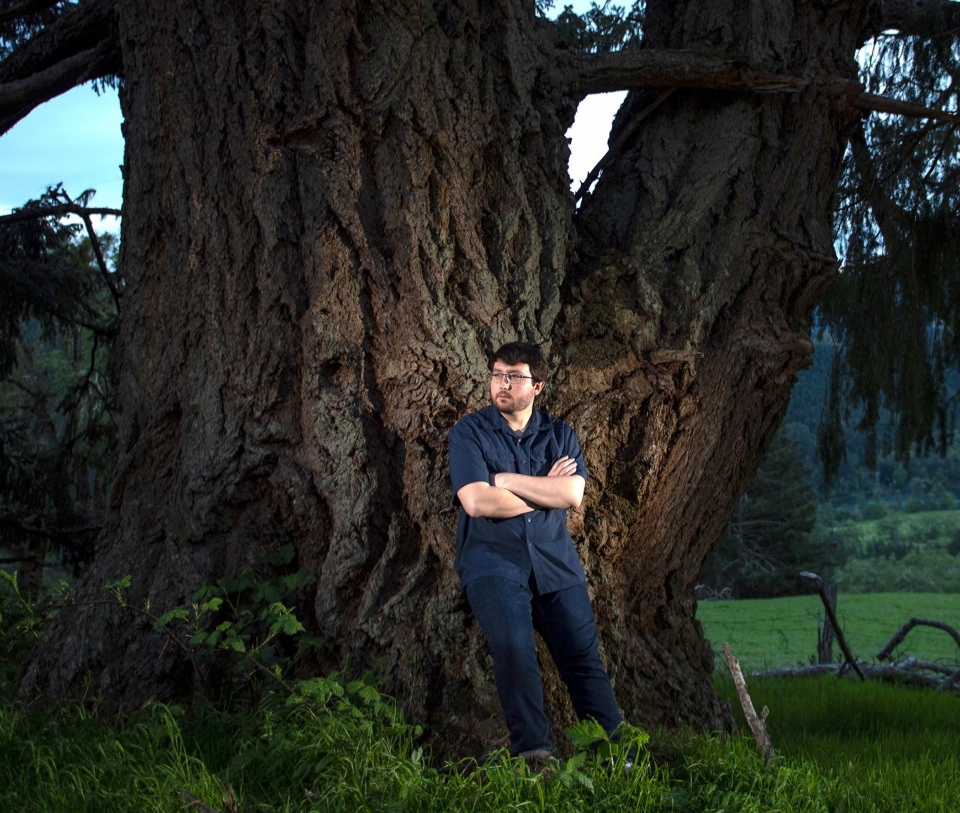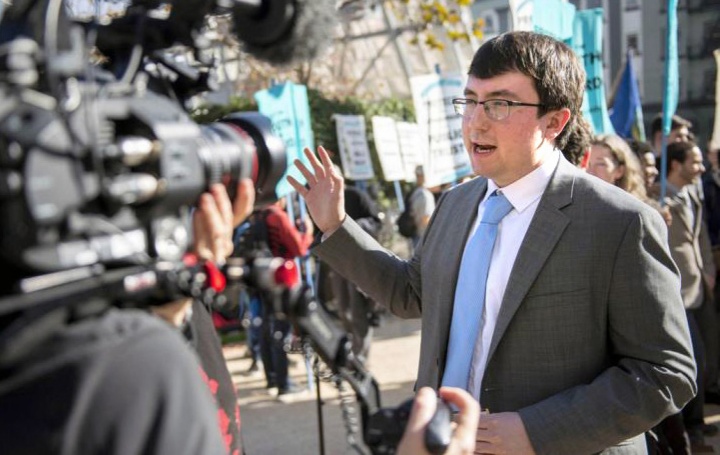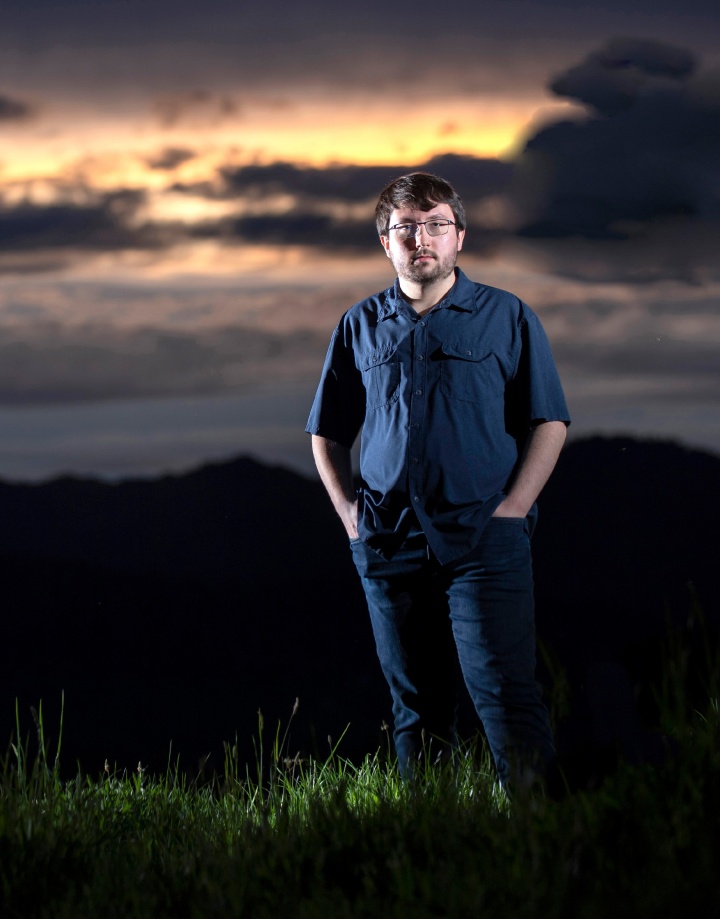Alex Loznak ’19 is one of a team of young people suing the U.S. government for the
right to a safer planet.
Columbia College | Columbia University in the City of New York
Alex Loznak ’19 is one of a team of young people suing the U.S. government for the
right to a safer planet.

Loznak at his family’s 152-year-old farm outside Eugene, Ore.
All Photographs by Robin Loznak
On August 12, 2015, Alex Loznak ’19 walked into the federal courthouse in Eugene, Ore., with 20 other young people to sue the U.S. government. Their groundbreaking claim? That the government’s lack of response to the growing climate disaster violated their Fifth Amendment rights, including, notably, their right to life. A life not threatened by extreme weather events; by wildfires, earthquakes and floods; by ocean warming and acidification, and so much more — in short, a life not threatened by the terrible, tangled ramifications of unchecked climate change.
The case, Juliana v. United States, accused the federal government of knowingly ignoring the catastrophic effects that carbon dioxide pollution and the country’s reliance on fossil fuels was having on the climate; further, that by supporting and promoting the country’s current energy systems, its actions were actively harming the plaintiffs.
The young litigants hailed from across America — Hawaii, Florida, New York, Oregon, Colorado and more — united by a common cause and a willingness to push the envelope. Rather than seek policy change through legislation, and argue in the court of public opinion with climate change deniers and those who put profits and short-term gains ahead of long-term sustainability, the plaintiffs took their belief in a constitutional right to a clean environment straight to federal court. At stake is nothing less than their — and our — futures.

The plaintiffs in Juliana v. United States make their voices heard outside the Ninth Circuit Court of Appeals in San Francisco in December 2017.
On the morning of March 12, I hopped on a shuttle bus to Newark Liberty International Airport, one of only three passengers on the usually crowded ride. The coronavirus outbreak was still in its early days in the United States, but potential travelers had already grown wary. My editor and I had spent the week before going back and forth on whether my trip to Oregon was still safe — a debate I promptly reopened via text as I took in the empty streets of Midtown and wondered whether I’d be putting myself and others at risk by boarding a cross-country flight.
Loznak and I had weekend plans to tour his family’s farm an hour outside Eugene, and to talk about how the case that has been part of his life for the last five years has changed him. He was going to walk me through the hazelnut grove that he helped plant nine years ago and show me the swaths of old-growth Douglas firs that dot the landscape. I was eager to see the place that he had affectionately described as both “beautiful” and “in the middle of nowhere,” and to learn how his experience growing up on a rural farm had influenced his environmental passion.
Halfway through my bus ride, word came via email that all Columbia employee travel was suspended immediately. My decision had been made for me — I would not be getting on a plane. In a flurry of emails with Loznak, we decided on a new approach to tell his story. Over the next few months we caught up several times by phone, as remotely connecting became the new normal.
The 570-acre Martha A. Maupin Farm has sat on the banks of Oregon’s Umpqua River since 1868, passing from family member to family member through the generations. It has long been an important source of food and revenue for Loznak and his family: Plum trees grow in verdant orchards (the farm has historically produced prunes from their fruit); chickens and grass-fed cows are raised (the family earns money from leasing pasture land to cattle ranchers); and a large garden supplies fruits and vegetables for personal consumption. Nestled in the Coast Range Mountains, the farm is also home to wild animals like elk and deer, and Loznak enjoys fishing for small-mouthed bass and salmon in the Umpqua River.
But in recent years, the 152-year-old farm has faced challenges its founding matriarch, Martha A. Maupin (Loznak’s great-great-great-great-grandmother), couldn’t have anticipated when she became one of the first women in Oregon to independently own ranch land. The state’s growing drought conditions — as well as heat waves and the increasing frequency of encroaching wildfires — threaten the farm’s future.

Media interviews have been a key part of Loznak’s role since the case was filed in 2015.
Loznak, a sustainable development and political science double major, is the seventh generation to live and work on the farm. Before joining the Juliana case, he had already been a passionate defender of the environment. He founded the Climate Change Club at Roseburg H.S., with the goal of installing solar panels on the school’s roof, and the League of Umpqua Climate Youth, which is dedicated to the conservation of the Umpqua River’s watersheds. Loznak also crusaded against the construction of the Jordan Cove LNG (liquefied natural gas) facility and its proposed 234-mile pipeline; the latter would cross the Coast Range Mountains as well as five major rivers, including the Umpqua. (The original Juliana court filing spoke specifically to Loznak’s pipeline opposition: “Alex has walked along the pipeline route and has seen the old growth trees that will be logged and the special rivers that will be impacted in order to deliver natural gas to what would be the largest, most-polluting facility and power plant in Oregon.”)
“He was very excited about the possibility to bring his story and his family’s story to this case.”
Through his work, Loznak became acquainted with local activists and Oregon’s environmental law community, and learned there was a movement brewing to challenge the federal government directly for environmental protections. This new case would focus on young people — and the dire future they face if immediate action isn’t taken to fight climate change.
“I’ll never forget when Alex was first emailing me and calling me,” says Julia Olson, executive director and chief legal counsel of Our Children’s Trust, the Oregon-based law nonprofit that is spearheading the Juliana case. “He was very persistent and very excited about the possibility to bring his story and his family’s story to this case.”
For Loznak, Juliana boils down to a simple demand: “Basically, what we ask is for a court order directing the government to get serious and put together a plan to abate greenhouse gas emissions of the United States and prevent climate change from reaching a level that would be unsafe for youth, both now and in the future.”
Juliana v. United States takes its name from lead plaintiff Kelsey Cascadia Rose Juliana, an Oregonian whose activism began in the fifth grade; at 15 she co-filed a lawsuit against Oregon’s governor asking for an emissions reduction plan, and at 18 she walked 1,600 miles from Nebraska to Washington, D.C., as part of a march for climate action. She’d turned 19 by the time the current case was filed, the oldest of the 21 plaintiffs. The youngest was 8, hailing from a Florida barrier island dealing with sea level rise and waters threatened by red algae blooms.
Among the other plaintiffs are an Arizona resident driven from her home on the Navajo Nation Reservation because of water scarcity; a Louisianan who has experienced eight 500-year floods — and one 1,000-year flood — in her state in just two years; and an Alaskan who has endured the effects of climate change on either end of the spectrum, from plummeting air quality due to wildfires, to an ice storm that robbed his family of power for a week in 18-degree temperatures. Their and the other plaintiffs’ stories together paint a vivid picture of the physical and psychological harm being caused; their sworn testimony details negative health impacts, emotional trauma and damage to their cultural heritages.

The hazelnut orchard is still several years away from producing at a commercial level.
For a group who mostly couldn’t even vote, their charge into what many have likened to a David-and-Goliath battle was a remarkable assertion that young people have a voice and power. They were also flipping the script by calling the adults to task for abdicating their responsibility as leaders and not embracing or instituting policies that would slow or reverse the environmental devastation. As one climate reporter for The Atlantic put it, “The kids were asking a federal court — and, inevitably, the Supreme Court — to take one of its most extraordinary interventions into American life since Brown v. Board of Education.”
Juliana has slowly crawled through the legal system since that first filing in the U.S. District Court for the District of Oregon in 2015, being repeatedly met with attempts by the defendants to squash the case without its reaching trial. As Loznak succinctly puts it: “Most of my time in college — and since college — the U.S. government has been trying to get the case dismissed.”
A major blow was dealt in January of this year, when a three-judge panel in the U.S. Ninth Circuit Court of Appeals ruled 2–1 to dismiss the case. The majority said that despite the strong evidence that the plaintiffs had suffered from climate change, judicial action was not the solution. “Reluctantly, we conclude that such relief is beyond our constitutional power,” Hon. Andrew Hurwitz wrote in the majority opinion. “Rather, the plaintiffs’ impressive case for redress must be presented to the political branches of government.”
However, says Olson, “That’s not the end of the road.”
In March, the plaintiffs filed a petition for rehearing en banc with the Ninth Circuit Court of Appeals; such a hearing would convene a new panel of 11 Circuit Court judges to review the January decision. But by mid-March, the COVID-19 outbreak had spread across the U.S., closing courthouses and further delaying the response of the courts. Even with the proceedings in limbo, Loznak remains hopeful: “We’re in it for the long haul,” he says. And regardless of how the rest of the case unfolds, it’s already had a big impact.
“I think I might be the first person in U.S. history to study my own case in a law school course while the case was still pending.”
“The Juliana case was one of the first times that federal judges have taken seriously the idea that there could be a constitutional right to a clean environment,” says Michael Gerrard ’72, an environmental attorney and the founder and director of Columbia’s Sabin Center for Climate Change Law. “The Juliana litigation was an important organizing tool, and [has] increased the consciousness of many young people about the importance of fighting climate change.
“Both the majority and the minority opinions from the Ninth Circuit contained powerful language about the dangers of climate change and the ability of people to sue about it that I expect will be quoted in many legal briefs in the years to come. The case is an instant classic and will be in the casebooks for a long time.”
At the College, Loznak balanced classes with the case, including Juliana-related trips to Washington, D.C., research trips, and media interviews and appearances. As part of his efforts to build the fact record of the case, Loznak traveled to presidential libraries around the country to try to find the earliest government acknowledgment of climate change. He struck pay dirt in Boston, where he discovered, in a collection of letters, that President Kennedy was made aware of the dangers of burning fossil fuels and the resulting greenhouse gases as early as 1961.
Loznak recalls what it was like to hold “that very thin letter, the very same piece of paper that President Kennedy had held in his hands about 60 years earlier.” He adds, “The Kennedy Presidential Library is on the waterfront in Boston; it’s a very low-lying structure on the oceanfront. It was eerie to hold that piece of history and then to look out the window across the ocean and see how close we are to actually going through the catastrophe that was predicted all those years ago.”
That document was later used in Juliana, as proof the government had longstanding knowledge of climate change.

He recalls meeting Democratic Whip Richard J. Durbin (D-Ill.) during a trip to D.C. “It was very interesting to also have the real-world experience of actually meeting some of the biggest players in terms of making policy, making laws. It added a whole other dimension to my education on these topics.”
During his senior year, Loznak did a research internship with the Sabin Center. Together with his research partner, Madeleine Siegel SPS’20, Loznak reviewed federal environmental impact statements and environmental assessments issued by U.S. federal agencies in 2017–18. A look at 26 of these documents, for projects related to fossil fuel production, processing and transport, led them to conclude that federal agencies do not adequately consider how their actions will affect climate change — findings that, for Loznak, reinforced the value of the Juliana case.
“Basically, we have a system of environmental laws — passed about 50 years ago — that is just not living up to the task of dealing with climate change, so there needs to be some kind of new approach to get us where we need to go. The Juliana case is at least an attempt to do that and to approach the problem in a creative, new way — that is, using constitutional law to try to force action at the national level.”
Loznak also took classes with Gerrard, who became a mentor to him as he navigated the courtrooms. (“Alex was extraordinarily engaged with the material,” Gerrard says, “and participated in class discussions very energetically.”) Loznak was even in Gerrard’s
“Climate Change Law and Policy” class when the Juliana case was discussed. “I think I might be the first person in U.S. history to study my own case in a law school course while the case was still pending,” Loznak says. “That’s a surreal experience.”
After graduation, Loznak headed back west, taking a job at a Eugene law firm; he plans to start law school at the University of Oregon this fall. When he and I caught up in May, he had left his apartment in Eugene to spend the coronavirus lockdown at the farm.
Read more about Michael Gerrard ’72 and the battle for climate change in our recent “Like Minds” feature, “The Denial of Science: We’re Already in Hot Water.”
As we talked about how much the country had changed since our planned tour, he ruminated on how the pandemic had reinforced the importance of small farms like his family’s. “We’re starting to see, in some ways, the fragility of the large-scale, industrial agricultural system that we have here in the U.S., which is focused on mass producing as much of these basic commodities — beef, eggs, dairy, corn and so on — as possible at the lowest possible cost,” he says. “But when you have a shock, like the coronavirus, you start to see not only the environmental limitations of that system but also the basic health and safety issues.
“The kind of agriculture we do is smaller scale, it’s lighter on the land and it’s ultimately healthier and more sustainable; it’s a model that we can look to as we, I hope, move to a sustainable form of agriculture.”
Loznak further reflects on the farm’s hazelnut orchard that he helped plant, and which is still a few years away from producing on a commercial level: “As a farmer, you really have to think on decadal or multi-decadal time scales, so that’s one reason I think coming from a farming background gives me a certain insight into the climate problem,” he says. “It’s a long-term thing. It’s not day to day, it’s not month to month — it’s year to year and decade to decade.”

Published three times a year by Columbia College for alumni, students, faculty, parents and friends.
Columbia Alumni Center
622 W. 113th St., MC 4530, 6th Fl.
New York, NY 10025
212-851-7852
cct@columbia.edu

Columbia Alumni Center
622 W. 113th St., MC 4530, 4th Fl.
New York, NY 10025
212-851-7488
ccalumni@columbia.edu